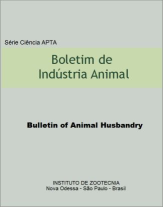Influence of essential oil odor of Corymbia Citriodora on the posture and hatchability of Rhipicephalus Microplus eggs
Keywords:
eucalyptus, odor, tickAbstract
Rhipicephalus microplus causes great economic losses to livestock breeders. Ticks have olfactory receptors called Haller's organs that are capable of detecting the odor of volatile substances. An effective product against ticks should act on the laying and hatching of eggs. This work evaluated the influence of the odor of Corymbia citriodora essential oil (eucalyptus) on egg laying and hatching of engorged females (teleogines) of R. microplus. The study was carried out in the Parasitology Laboratory of the CPDGRA, Institute of Zootechnics, Nova Odessa, São Paulo, state. C. citriodora essential oil, obtained from the company Dierberger Óleos Essencias, was diluted at concentrations of 10, 20, 40, 60, 80 and 100 mg.g-1. A sample (1 ml) of each concentration was poured onto a filter paper disc (4.5 cm diameter), which after total evaporation of the solvent was transferred to the experimental unit, composed of 2 Falcon tubes with 50 ml capacity, which were coupled to each other forming two compartments: A (upper tube receiving teleogines) and B (lower tube receiving the filter paper disc impregnated with the oil at different concentrations). Tube A was cut at the bottom (1 cm from the base) and an inlet with tube B with filter paper allowed the odor from tube B to pass to tube A. The cover of tube A was perforated and closed with another filter paper to allow the essential oil to volatilize. After the exposure time (72 hours), the teleogines were transferred from the experimental units to a Petri dish and incubated in a BOD with controlled temperature (27 °C) and humidity (80%) to perform egg laying (28 days). The eggs were weighed and placed in glass vials (10 ml) sealed with cotton, and after hatching, the percentage of larvae born was evaluated. The tests were performed with 5 replicates with 5 teleogines for each replicate. Up to 72 h the experimental units were kept at room temperature (about 28 °C) inside a tray of water and exposed to a humidifier to ensure moisture. The control treatment was put in a different place. The analysis of variance showed a significant difference (P<0.001). The efficiency of the product (EP) was calculated using the formula: EP = (CRI (control reproductive index) - TRI (treated reproductive index) / CRI) x 100. The Tukey test was used to compare the differences between means at 5% significance. Statistical calculations were performed by Minitab release 13. The egg masses from the treated teleogines were lower than the control ones (P<0.05), and they did not differ from each other (P>0.05). There was no difference in the weight of teleogines between treatments (P>0.05). The average weight of the egg mass from treated teleogines was 0.189 g, whereas the control was 0.330 g, a reduction of 57.3%. In relation to the mean percentage of hatching, treatments with 10, 80 and 100 mg.g-¹ concentrations were equal (P>0.05) and higher than the other treatments (P<0.05), with averages of 10%, 22% and 3.2% hatchability, respectively. We can conclude that odor of essential oil of Corymbia citriodora affects the teleogines exposed to it because they laid fewer eggs and the hatchability of these eggs was also impaired. This fact encourage the study of a new way to apply acaricides through fumigation, instead of direct contact with the tick.
Downloads
Downloads
Published
Issue
Section
License
Os autores não serão remunerados pela publicação de trabalhos, pois devem abrir mão de seus direitos autorais em favor deste periódico. Por outro lado, os autores ficam autorizados a publicar seus artigos, simultaneamente, em repositórios da instituição de sua origem, desde que citada a fonte da publicação original seja Boletim de Indústria Animal. A revista se reserva o direito de efetuar, nos originais, alterações de ordem normativa, ortográfica e gramatical, com vistas a manter o padrão culto da língua e a credibilidade do veículo. Respeitará, no entanto, o estilo de escrever dos autores. Alterações, correções ou sugestões de ordem conceitual serão encaminhadas aos autores, quando necessário. Nesses casos, os artigos, depois de adequados, deverão ser submetidos a nova apreciação. As opiniões emitidas pelos autores dos artigos são de sua exclusiva responsabilidade. Todo o conteúdo deste periódico, exceto onde está identificado, está licenciado sob a Licença Creative Commons Attribution (CC-BY-NC). A condição BY implica que os licenciados podem copiar, distribuir, exibir e executar a obra e fazer trabalhos derivados com base em que só se dão o autor ou licenciante os créditos na forma especificada por estes. A cláusula NC significa que os licenciados podem copiar, distribuir, exibir e executar a obra e fazer trabalhos derivados com base apenas para fins não comerciais.













